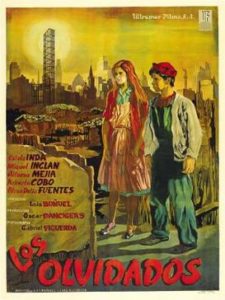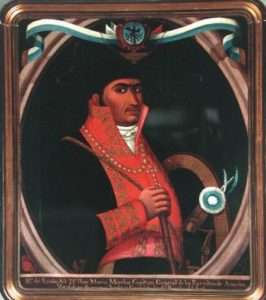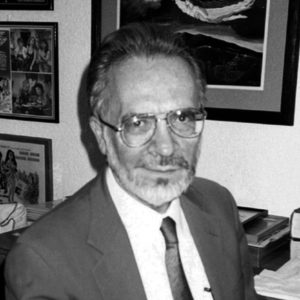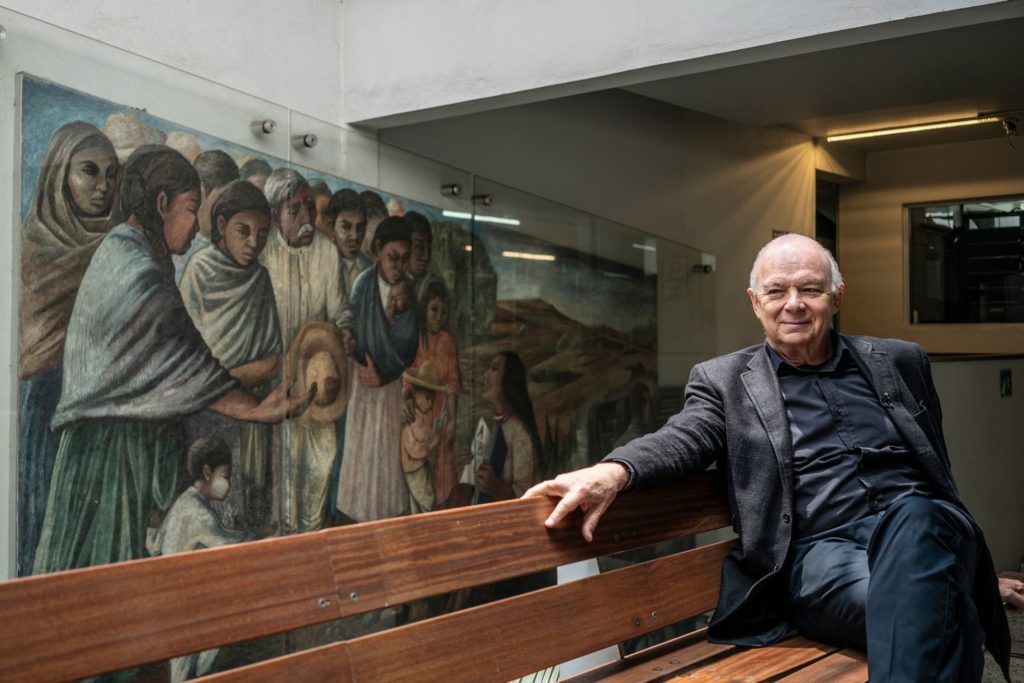Editor’s note: The war of Mexican independence from Spain began on 16 September 1810, when an ethnic Jew, Miguel Hidalgo y Costilla, uttered the so-called ‘Cry of Dolores’, stirring up the Indians against the Spaniards.
The Breve Historia de México, which José Vasconcelos wrote in 1936, runs on a premise: as long as a civilisation of Spanish, Criollo origin (ethnic Spaniards with no Indian blood born in the American continent), dominates in Mexico, there is prosperity; when native barbarism imposes itself, disasters befall inhabitants of that country. However, as Vasconcelos was a Catholic, he never realised that the ideas of equality weren’t only English ideas, whom he blames for what happened in the War of Independence, but Christian ideas mutated into secular ideology.
Without adding ellipses between unquoted paragraphs, in this post I translate a passage from Vasconcelos’ book. The brackets are mine:
______ 卐 ______

In Bustamante’s medal we can read: ‘Siempre Fieles – Siempre Unidos – 1838’. And Alamán narrates that in all of Mexico there was rejoicing, when the Argentines triumphed over the English, when Spain rose against the French. And there was an offer of resources or volunteers for war to the common enemy who later suggested to Hidalgo, to Morelos, the criminal war, the disloyal slaughter, precisely of the Spaniards, of our fathers, of our brothers. And there were still loose in our squares and streets, the demagogues with Criollo mezcal eloquence shouting in favour of abstractions: liberty, equality, fraternity.
The perverse doctrine
Father Mier, who is presented to us as the inspirer of the Independence movements, developed his propaganda in London, always in the pay of the British Admiralty. He claimed, in effect the English doctrine, that Mexico was separating from Spain because the pacts of the Conquest [of the Aztec Empire] had been violated. What were these pacts? Who thought they existed, and, if they did, how was it that the phenomenon of Latin American independence gained the most momentum in Argentina, where there were no Indians to enter into such pacts? Why was Mexico, the typically Indian country, precisely the one that showed the least enthusiasm for Independence?
Mier suspected none of this, and propagated the thesis of the traditional interventionists, the hypothesis of the indigenous claims that were then being asserted against the Spaniards and that were later wielded against the Criollos and today are used to dispossess, to persecute those who speak Spanish, with no exceptions for the Indians. Indeed, there is talk of indigenous claims as if at the time of Cortés’ arrival the Indians had been owners, as if property and the Christian concept of the rights of the human person had not appeared precisely with the conquest.
But the truth is that the independence of New Spain was promoted by the Criollos and the Spaniards of New Spain, Mexicans of the most recent generation, and not to recover usurped rights of any kind. On the contrary, the descendants of Moctezuma, as well as those of many other characters of Aztec times, lived in Spain as nobles and opposed the independence that would make them lose their titles and their advantages. But to speak of indigenous demands in the name of a nationalism that never existed is something that could not have been born in the heart of the Mexican people, but was inspired from outside, like a poison destined to poison their future.
Mexican loyalty
Alamán rightly observed that ‘it was ungenerous to pretend to turn away from a nation with which Mexico had been linked for three centuries’. Hidalgo himself evoked the name of Ferdinand the Seventh, perhaps thinking that once Spain had been freed from the French invasion, Independence would follow. They did not come to Mexico, as they did to Colombia, with Bolivar, with English battalions and foreign general staffs, no doubt because Spanish sentiment was stronger among us.
Independence—achieved without bastard advisors like those who led Hidalgo and Morelos astray—was already being achieved. But that was not what the British wanted. What they wanted was to drive the Spaniards out of their dominions in America, to dominate the natives at once as one dominates flocks without a shepherd… [The movement] was diverted, by iniquitous foreign pressure, into the ignorant and destructive caudillismo of the Morelos and Guerreros, whose programme in essence went no further than the demand to kill gachupines [Spaniards], the natural slogan of the English.
Independence in Mexico did not fight battles. There have never really been battles on our soil, but bloody hecatombs of civil war. And it has had to resort, as we shall see in another chapter, to the dangerous system of exalting defeats. For all our foreign warlords are, after all, defeated. But to be specific in the case of Independence, it is an auspicious fact that no great battles were fought, that there were no great armies, and that Calleja, as he constantly repeated with all loyalty, was waging war against the warlords of Independence exclusively with Mexican troops. We Mexicans wanted independence but we were loyal. We did not want independence for the benefit of the British, but the benefit of our homeland. That is why the nation, in its conscious sectors, did not follow Hidalgo, did not follow Morelos. Everyone must have been suspicious of that eagerness to kill gachupines and that insistence on recruiting pure Indians and blacks from the coast of Guerrero, to throw them on the populations to plunder, to destroy, which is the only thing that the improvised leader who has no plan and no vision achieves.
To realise the tactics of Hidalgo and Morelos, tactics of the forerunners of the American party, tactics which produced friendships in the United States and promises of aid, such as driving Hidalgo northward, such as moving Morelos to dispose of Texas, let us imagine a similar case in another nation. Suppose that the French who aided American independence, instead of meeting with superior men like Franklin, like Washington, like Hamilton, men who knew how to take advantage of foreign aid, but without submitting to its ends, turned it rather to their service, had had recourse in the United States to the mulatto population, ignorant and degraded, and, therefore, predisposed to treachery. To these half-breeds of black and white the French agent, the enemy of all things English, would have said, and rightly so:
‘You have been ruled for three centuries by an aristocracy of hypocritical Quakers who presume to be righteous, and here they are seizing all the land, all the wealth, keeping millions and millions of blacks in slavery. The battle cry must be “Death to the British”, and every time you occupy a village, shoot all the subjects of England you manage to capture’.
What would the leaders of American Independence have done in the face of such propaganda? They would have taken no more than five minutes to have those who listened to such propaganda shot! What would Washington himself have done if the overseer of the slaves on his farms went into rebellion to kill Englishmen? At that very moment, Washington, who was well-born, would have felt English and would have sought first to beat first the traitors of his blood and then the agents of the oppressive power that was England. Well, that explains why so many did not follow Hidalgo and Morelos but let them be executed, without prejudice to continue working for Independence, without prejudice to consummate independence, but no longer to the cannibalistic cry of ‘Death to the Gachupines!’
I ask the pure Indians of my country, and my compatriots already educated and clear of mind and heart: Was there or was there not oppression, abuse, or slavery of the blacks in the region of America colonised by the English? And yet, what would have happened if the warlords of American Independence, instead of fighting against the English troops, summoned the blacks, called them and told them: ‘Now to kill the British’? Is it true or not true that the United States would have become supper for blacks?
We have just said that the fate of Mexico would have been different if its national leaders at the time of Independence had had the cultural and human stature of the Franklin, the Hamiltons, and the Adamses. We had one or two in that period who can be compared with the best of any country. Bishop Abad y Queipo and the civilian Don Lucas Alamán. A character of constructive stature could perhaps have been developed with the figure of Licenciado Verdad, Mayor of Mexico. But there was a lack of intelligence in the wealthy, enlightened class.
The greatest crime in history is to dress up in tinsel events that have been the cause of the backwardness and decadence of nations. And this is what we have done with the legend of Independence: to erect as a cult and a religion what was a disastrous mistake and the beginning of all our misfortunes. It is better to have no idols than false ones.
The precursor movements
From the beginning, Pereyra notes, the purely Spanish Criollismo will carry the banner of Indianism against the Metropolis; it will be called Aztequismo in Mexico, Incaismo in South America, Mosquismo in New Granada, Caribdismo in Venezuela. Each country will find in a remote pre-Columbian glorification the starting point of its national aspirations.
But all this was not only artificial and absurd, it was part of the British programme which, together with wages, taught a lesson to the forerunners and actors of the great insurrectionary movements.
An obscure Indian rebellion aimed at suppressing the work tributes was magnified into a continental banner. It happened that the rebel cacique Condorcanqui was baptised by those who had sold their souls to England with the name of Tupac Amaru, the name of the Inca executed by the Spaniards. And he was presented as the would-be Emperor of all America, when, Pereyra rightly says, his ancestor, the real Tupac Amaru, never had any pretensions to conquer even as far as Bogota. All the new Tupac did before he was soundly defeated was to slit the throats of men, women and children. In Calca he wiped out all the whites. This indicates the trend of the insurrection. And so the question arises again: What would the Americans have done with an uprising which, under the pretext of national independence, would have launched the redskins of the Cañada against the outposts of the thirteen primitive colonies? They would have done what Calleja did when there was no more war cry and no more plan than to kill gachupines: beat them to death.
The documents drafted by the British were no more effective in achieving the purpose that would serve as the basis of the war: the spread of hatred between Criollos and Spaniards. This was the origin of the contemporary imperialist action that stirred up the hatred of the mestizos against the Criollos and of the Indians against the mestizos.
Rather than French egalitarian and liberal, the ideas of the forerunners of Independence were borrowed from the Intelligence Service of the English Admiralty; they were fabricated by the enemies of Spain who coveted our territories. They were ideas of social derangement, useful to produce what would soon define American imperialism, more practical and more outspoken than English imperialism: the extermination of the inferior mixed races that Spain had produced and the conquest of the land without the men, ‘the cage without the bird’. In other words, the tactic that the Americans applied in their territories, ‘A good Indian is a dead Indian’. In our countries, the Spaniard had to be wiped out first because the Spaniard had married the Indian, allied himself with the Indian and had come to form the powerful mestizo bloc. It is by attacking them in the head, by destroying their aristocracies, that the enemy races are best and soonest destroyed. That is why the war cry, a hypocritical and disloyal cry, was from one end of the continent to the other and even there where there were no Indians to claim a single right: ‘Up with the Indians, the Tupac Amaru of operetta and… let the gachupines die!’
Miranda dreamed, as Bolivar dreamed at first, that by simply establishing freedom, all the republics of America would live in peace. He did not see the American danger, added to the English danger. And if Bolivar did see it, it was when, already in decadence and exile, the lucidity of one who has failed in an enterprise he judged noble came to his spirit.
Miranda also fell into the childishness of wanting to give the government of a vast American state to the descendant of the Inca. So we can see how even the men of genius of the movement served the Anglo-Saxon plan to eliminate the Spanish from the territories they were preparing to conquer. And yet Miranda had not a drop of indigenous blood in him. He was merely a soul mediated by the influence of the English.
Where is the judgement of all these men we revere as fathers of the fatherland? If Miranda, a man of the world, enlightened, almost brilliant, offered the provinces, what is so strange that Morelos, lacking in enlightenment, spoke naturally of offering Texas to the United States in exchange for a few rifles?
Aaron Burr, too, an American character who later fell into disgrace, was preparing an expedition down the Mississippi. Its object, proclaimed by Jefferson, was the conquest of New Spain. It was not carried out because Spain was behind it. When we lacked Spain, the disaster of 1947 occurred.
The War of Independence
The Viceroy, in the meantime, organised a new army which he placed under the command of Don Félix María Calleja, a royalist general. On the plains of Aculco, northwest of the capital, Calleja waited with ten thousand men for Hidalgo’s one hundred thousand. They were a poorly armed rabble, composed mostly of Indians, and Calleja succeeded in destroying them.
The insurgent defeat was total. From that moment on Hidalgo’s only thought was flight. On his way north he was apprehended near Monclova. From there he was taken to Chihuahua, where he was executed after publicly recanting his entire enterprise.
On his passage through Michoacán, Hidalgo had received the support of the priest Don José María Morelos, his former pupil at the seminary of Valladolid. Morelos was not very enlightened. His ideas about his movement were those communicated to him by Hidalgo, who was confused about them. Hidalgo viewed the unmotivated slaughter of the Spaniards with distaste. Morelos, less educated, was more easily infected by the irritation of the mestizos and Indians against the Spanish. On Morelos’ side, American agents gained considerable influence. One of these agents, according to Alamán, was shot by Calleja. But not before he had witnessed with satisfaction the hecatombs of Spanish prisoners consummated by Morelos. The destruction of the Spaniards was necessary to destroy the country.

The lust for booty drove the multitudes against the Spaniard, for the dispossessed always hates he who has. The United States would have degenerated instead of prospering if, like us, they were engaged in persecuting Englishmen. On the contrary, Yankee policy has been to favour the immigration of English and Nordic people of all races related to their own. And the power of Argentina and Brazil is due to the fact that they continued to receive Spaniards and Portuguese respectively, at the same time that we were killing and expelling Spaniards. It was a drain on our ethnic aristocracy.
If on these and similar facts there is not the slightest doubt. If Morelos cannot be a model, neither as a military man nor as a patriot nor as a gentleman, why these unlimited glorifications? To raise to the highest summit of patriotic fame one who suffers from such scourges, takes away authority to demand from the officials and caudillos of the day, the elementary virtues of the man of honour. Because how can we ask from the common official what is not demanded of the hero? On the other hand, there is nothing sadder than a people whose history is not even clean. To keep it dirty is not the fault of the characters who appear in it, but the fault of the crowd of intelligentsia hired out to the vilest powers of the moment, who repeat legends and bestow thoughtless or perniciously motivated consecrations, often to cover up and justify the crimes of the present.
 This is the only Mexican film on my list of 50. The director wasn’t Mexican but Spanish, Luis Buñuel (1900-1983), whom I met in the living room of Arturo Souto Alabarce’s family a few years before he died. Part of Los Olvidados was filmed very close to where I now live, although the area has changed a lot in the last seventy-three years.
This is the only Mexican film on my list of 50. The director wasn’t Mexican but Spanish, Luis Buñuel (1900-1983), whom I met in the living room of Arturo Souto Alabarce’s family a few years before he died. Part of Los Olvidados was filmed very close to where I now live, although the area has changed a lot in the last seventy-three years. 







